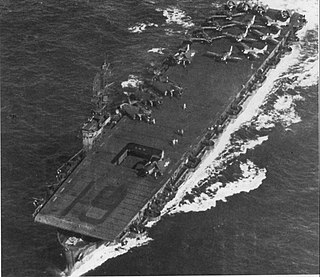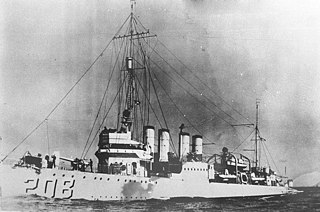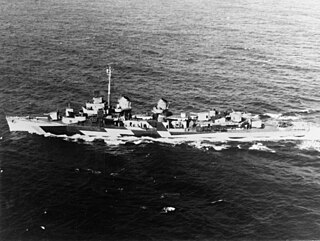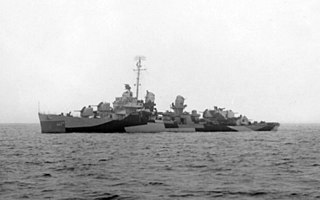
USS Bismarck Sea (CVE-95) was the fortieth of fifty Casablanca-class escort carriers built to serve the United States Navy during World War II; she was the only ship of the United States Navy to be named for the Battle of the Bismarck Sea. Completed in May 1944, she served in support of the Philippines campaign, and the landings on Iwo Jima. On 21 February 1945, she sank off of Iwo Jima due to two Japanese kamikaze attacks, killing 318 crewmen. Notably, she was the last aircraft carrier in U.S. service to sink due to enemy action.

USS Salamaua (CVE-96) was a Casablanca-class escort carrier of the United States Navy. She was named after the invasion of Salamaua, a strategically important village in the New Guinea Theater during World War II, and one of the main targets of the Salamaua–Lae campaign. She served with distinction during the war, notably being damaged in early 1945 by a kamikaze aircraft during the Invasion of Lingayen Gulf, killing 15 crewmen and injuring 88. Post war, the ship helped repatriate servicemen to the United States as part of Operation Magic Carpet before being decommissioned and struck in 1946, and ultimately being broken up in 1947.

USS White Plains (CVE-66) was a Casablanca-class escort carrier of the United States Navy. She was named after the 1776 Battle of White Plains.

USS Hoggatt Bay (CVE-75) was the twenty-first of fifty Casablanca-class escort carriers built for the United States Navy during World War II. She was named after Hoggatt Bay, which was named in 1895 by Lieutenant commander E. K. Moore after Wilford Bacon Hoggatt, an ensign serving in Moore's party at the time. The bay is located within Baranof Island, part of the Alexander Archipelago, which at the time was a part of the Territory of Alaska. She was launched in December 1943, commissioned in January 1944, and she served in the Mariana and Palau Islands campaign, the Invasion of Lingayen Gulf as a part of the Philippines campaign, as well as the Battle of Okinawa. Post-war, she participated in Operation Magic Carpet, repatriating U.S. servicemen from around the Pacific. She was decommissioned in July 1946, being mothballed in the Atlantic Reserve Fleet. Ultimately, she was broken up in 1960.

USS Marcus Island (CVE-77) was the twenty-third of fifty Casablanca-class escort carriers built for the United States Navy during World War II. She was named after an engagement on 31 August 1943 over Minami-Tori-shima, known on American maps as Marcus Island. She was launched in December 1943, commissioned in January 1944, and she served in the Mariana and Palau Islands campaign, the Philippines campaign, as well as the Battle of Okinawa. She spent the majority of her World War II as a flagship for various escort carrier formations, serving as the headquarters for Rear Admiral William D. Sample and Felix Stump. During the Philippines campaign, she participated in the Battle off Samar, the largest naval engagement in history, and during the Battle of Mindoro, she had multiple near-brushes with Japanese kamikazes. Post-war, she participated in Operation Magic Carpet, repatriating U.S. servicemen from throughout the Pacific. She was decommissioned in December 1946, being mothballed in the Atlantic Reserve Fleet. Ultimately, she was broken up in 1960.

USS Manila Bay (CVE-61) was a Casablanca-class escort carrier of the United States Navy.

USS Ommaney Bay (CVE–79) was a Casablanca-class escort carrier of the United States Navy, which served during World War II. It was named after Ommaney Bay, located at the south end of Baranof Island, Alaska. Launched in late 1943 and commissioned in early 1944, the ship took part in the Mariana and Palau Islands campaign followed by several battles during the Philippines campaign in 1944 and early 1945. She was heavily damaged in a kamikaze attack and subsequently scuttled on 4 January 1945, with the loss of 95 men, including two men on board the destroyer escort Eichenberger who were killed by flying debris. She earned 2 battle stars whilst in service. In 2023, the Navy History and Heritage command announced that the wreck was located by "a combination of underwater survey and video information provided by Sea Scan Survey and DPT Scuba, two Australian diving firms, to positively identify the wreck."

USS Steamer Bay (CVE-87) was a Casablanca-class escort carrier of the United States Navy. She was named after Steamer Bay, located within Etolin Island, Alaska. Launched in February 1944, and commissioned in April, she served in support of the Invasion of Lingayen Gulf, the Invasion of Iwo Jima, and the Battle of Okinawa. Postwar, she participated in Operation Magic Carpet. She was decommissioned in January 1947, when she was mothballed in the Pacific Reserve Fleet. Ultimately, she was sold for scrapping in August 1959.

USS Shamrock Bay (CVE-84) was the thirtieth of fifty Casablanca-class escort carriers built for the United States Navy during World War II. She was named after Shamrock Bay, located within Baranof Island, of the Territory of Alaska. The ship was launched in February 1944, commissioned in March, and served in support of the Invasion of Lingayen Gulf, the Invasion of Iwo Jima and the Battle of Okinawa. Postwar, she participated in Operation Magic Carpet. She was decommissioned in July 1946, when she was mothballed in the Atlantic Reserve Fleet. Ultimately, she was broken up in November 1959.

USS O'Flaherty (DE-340) was a John C. Butler-class destroyer escort built for the United States Navy during World War II. She was named for Ensign Frank Woodrow O'Flaherty, a pilot who posthumously received the Navy Cross for his actions at the Battle of Midway.

USS Stafford (DE-411) was a John C. Butler-class destroyer escort in the United States Navy. She was named after Richard Y. Stafford (1916–1942), a United States Marine Corps Captain who died during the Battle of Guadalcanal.

USS Halligan (DD-584) was a Fletcher-class destroyer of the United States Navy, named for Rear Admiral John Halligan, Jr. (1876–1934).

USS Hovey (DD-208/DMS-11) was a Clemson-class destroyer in the United States Navy during World War II. She was the only ship named for Ensign Charles Hovey (1885–1911).

USS Twiggs (DD-591), a Fletcher-class destroyer, was the second ship of the United States Navy to be named for Marine Major Levi Twiggs (1793–1847).

The fourth USS Preble (DD-345/DM-20/AG-99) was a United States Navy Clemson-class destroyerin commission from 1920 to 1945. She served in China, including on the Yangtze Patrol, and later saw combat in World War II as a minelayer. She was named for Commodore Edward Preble.

USS Hank (DD-702), an Allen M. Sumner-class destroyer, was named for Lieutenant Commander William Hank.

USS Heywood L. Edwards (DD-663) was a Fletcher-class destroyer of the United States Navy, named after Lieutenant Commander Heywood L. Edwards (1905–1941), captain of the destroyer USS Reuben James, the first U.S. Navy ship sunk in World War II. Following the war, the ship was transferred to Japan and renamed Ariake. The ship served with the Japanese until 1974 and was scrapped in 1976.

USS Walter C. Wann (DE-412) was a John C. Butler-class destroyer escort built by Brown Shipbuilding at their yard in Houston, Texas. The ship was launched on 19 January 1944. The ship was sponsored by Mrs. Anna Wann, the mother of Pharmacist's Mate Wann, the ship's namesake. She was commissioned on 2 May 1944. The destroyer escort received four battle stars for World War II service. Walter C. Wann was decommissioned on 31 May 1946 and placed in reserve at San Diego, California after two years and one month active service. The vessel was struck from the Navy Register on 30 June 1968 for disposal. In June 1969 Walter C. Wann was sold to the National Metal and Steel Company, Terminal Island, California for scrap and broken up.

USS Oberrender (DE-344) was a John C. Butler–class destroyer escort built for the United States Navy during World War II. She was named for Lieutenant Commander Thomas Olin Oberrender Jr., the engineering officer of the light cruiser USS Juneau, who was killed when that ship was torpedoed and sunk during the Naval Battle of Guadalcanal in 1942.

USS Tills (DE-748) was a Cannon-class destroyer escort in service with the United States Navy from 1944 to 1946 and from 1950 to 1968. She was sunk as a target in 1969.




















